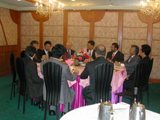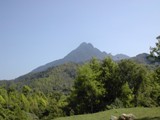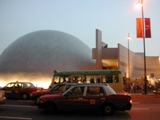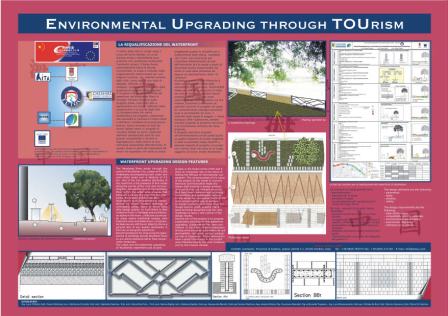
OUTLINE
The project aims to
devise, test and implement a transferable methodology to
improve a degraded urban waterfront at Wuzhishan City,
Hainan Province, Peoples Republic of China, using
tourism as a catalyst for regeneration. The methodology
will produce an action plan (Urban Tourism Action Plan)
which can be replicated in other urban areas, notably
those in Provincia di Avellino and Cheshire where
similar actions may be considered. Overall target groups
are the inhabitants of Wuzhishan City and its environs (population
107,000), located in the mountain interior of Hainan
where a large proportion (65%) are disadvantaged
minorities (Li and Miao), and, specifically, the
residents of the Nanshan River waterfront. Lack of
investment and increased unemployment are major problems
in the town as tourists have moved to the coastal areas.
The three main activities are: to upgrade the
environment of the Wuzhishan City waterfront; stimulate
urban tourism based on the city’s cultural heritage;
establish and test a consultation and implementation
framework for the five year plan
 THE
BACKGROUND EUTOU
is aimed at bringing important socio economic
improvements to Wuzhishan City, a city located in the
interior of Hainan Province where incomes are below
provincial average due partly to the presence of
economically under-privileged groups (notably the Li and
Miao ethnic people). Socio economic problems in the city
and surrounding area have not only resulted from
declines in traditional economic sectors such as
agriculture and manufacturing but also by a decline in
tourism, one of Hainan’s major economic sectors as the
province is China’s premier holiday destination. The
decline in tourism results from the opening up of new
coastal resorts (notably at Sanya and Boao), now
connected to international airports by a new coastal
motorway that has diverted tourist flows away from the
mountainous interior. The result has been considerable
out-migration to the coastal areas from Wuzhishan City
and a serious decline in investment, with hotels and
tourism attractions closing (notably the Chinese
National Cultural Village theme park). Such problems,
recently worsened by the recent SARS crisis affecting
tourism in China, have been recognised by HPTA as well
as the local municipal Government of Wuzhishan City.
HPTA, under the direction of a High Level Council for
the Promotion of Tourism Development, is responsible for
all aspects of tourism at provincial level and at local
level through its county divisions. Its work includes
planning, marketing, the collection and analysis of
statistics, manpower development and the supervision and
management of the sector. Importantly, HPTA’s Planning
Division is responsible for overseeing the Tourism
Master Plan for Hainan Province and for guiding and
planning the distribution of tourism development in
local areas, notably Wuzhishan City which has been
designated as a priority planning area for regenerating
tourism and the area’s socio-economic decline. The
Administration is responsible for advising and preparing
tourism development plans at city and county level.
THE
BACKGROUND EUTOU
is aimed at bringing important socio economic
improvements to Wuzhishan City, a city located in the
interior of Hainan Province where incomes are below
provincial average due partly to the presence of
economically under-privileged groups (notably the Li and
Miao ethnic people). Socio economic problems in the city
and surrounding area have not only resulted from
declines in traditional economic sectors such as
agriculture and manufacturing but also by a decline in
tourism, one of Hainan’s major economic sectors as the
province is China’s premier holiday destination. The
decline in tourism results from the opening up of new
coastal resorts (notably at Sanya and Boao), now
connected to international airports by a new coastal
motorway that has diverted tourist flows away from the
mountainous interior. The result has been considerable
out-migration to the coastal areas from Wuzhishan City
and a serious decline in investment, with hotels and
tourism attractions closing (notably the Chinese
National Cultural Village theme park). Such problems,
recently worsened by the recent SARS crisis affecting
tourism in China, have been recognised by HPTA as well
as the local municipal Government of Wuzhishan City.
HPTA, under the direction of a High Level Council for
the Promotion of Tourism Development, is responsible for
all aspects of tourism at provincial level and at local
level through its county divisions. Its work includes
planning, marketing, the collection and analysis of
statistics, manpower development and the supervision and
management of the sector. Importantly, HPTA’s Planning
Division is responsible for overseeing the Tourism
Master Plan for Hainan Province and for guiding and
planning the distribution of tourism development in
local areas, notably Wuzhishan City which has been
designated as a priority planning area for regenerating
tourism and the area’s socio-economic decline. The
Administration is responsible for advising and preparing
tourism development plans at city and county level.
 ACTORS
HPTA’s staff, which
includes English speakers, has experience of tourism
planning as well as town planning, architecture,
management, finance, business and administration. Its
skills are complemented by the Hainan Tourism
Development Planning Academy. HPTA has already taken
administrative and political steps to improve the
socio-economic situation of Wuzhishan City. The 2002
Tourism Master Plan for Hainan Province designated
Wuzhishan City a centre for cultural tourism (related to
the minority Li people) and a base from where to explore
the surrounding countryside (forests and famous national
landmarks such as Wuzhi Mountain). A new road to Sanya,
recently completed, now allows tourists to reach
Wuzhishan City from the coast in about an hour.
Notwithstanding there is considerable need for urban
improvements to make the city a more attractive place
for tourists, and to avoid its future by-passing by
visitors. As reported in the Tourism Master Plan for
Hainan Province, the city lacks local distinctiveness
and its potential, including the Nanshan River and its
status as the historical centre of the Li people, are
poorly exploited. Unlike famous cultural cities in China
where old urban areas need conservation and restoration,
the challenge in Wuzhishan City is more to create a
sense of place and interest in a relatively modern but
degraded urban environment (common to many Chinese
cities). The famous Nanshan River can be a key catalyst
for this Works funded by the National Government have
now begun to improve the flow of the river (currently
intermittent). To complement this, funding for upgrading
the waterfront and involving local people and actors to
promote cultural tourism, is urgently required.
ACTORS
HPTA’s staff, which
includes English speakers, has experience of tourism
planning as well as town planning, architecture,
management, finance, business and administration. Its
skills are complemented by the Hainan Tourism
Development Planning Academy. HPTA has already taken
administrative and political steps to improve the
socio-economic situation of Wuzhishan City. The 2002
Tourism Master Plan for Hainan Province designated
Wuzhishan City a centre for cultural tourism (related to
the minority Li people) and a base from where to explore
the surrounding countryside (forests and famous national
landmarks such as Wuzhi Mountain). A new road to Sanya,
recently completed, now allows tourists to reach
Wuzhishan City from the coast in about an hour.
Notwithstanding there is considerable need for urban
improvements to make the city a more attractive place
for tourists, and to avoid its future by-passing by
visitors. As reported in the Tourism Master Plan for
Hainan Province, the city lacks local distinctiveness
and its potential, including the Nanshan River and its
status as the historical centre of the Li people, are
poorly exploited. Unlike famous cultural cities in China
where old urban areas need conservation and restoration,
the challenge in Wuzhishan City is more to create a
sense of place and interest in a relatively modern but
degraded urban environment (common to many Chinese
cities). The famous Nanshan River can be a key catalyst
for this Works funded by the National Government have
now begun to improve the flow of the river (currently
intermittent). To complement this, funding for upgrading
the waterfront and involving local people and actors to
promote cultural tourism, is urgently required.
 THE START
Politically EUTOU is
supported in China by the 10th Five-Year Plan for
Provincial Tourism in Hainan. This outlines long term
goals for tourism development in the Province to 2010,
including improving the quality and variety of tourism
and related destinations (notably promoting urban and
cultural tourism). Improving the socio economic
conditions for ethnic peoples and fostering poverty
alleviation is also a key policy of both national and
provincial plans, including the current 10th Five Year
Plan for Social and Economic Development of Hainan
Province (to 2005). An important initiative already
undertaken by the EUTOU partnership has been the visit
to Hainan by a delegation from the Provincia di Avellino
in March 2003. This included technical meetings with
HPTA, local press conferences on the EUTOU initiative,
and site visits to Wuzhishan City to discuss the
technical feasibility of the project as well as a
consultation meeting with the Wuzhishan City Municipal
Government. The visit culminated in a meeting between
the two Governors of the respective provinces in Haikou.
An agreement of co-operation was signed by the two
governors at the meeting. The project will complement a
development project currently being carried out by the
National Government to improve the water flow of the
Nanshan River. This hydrological project, which includes
damming some sections of the river upstream will be
completed in 2004/2005 but will not involve any urban
regeneration of the waterfront.
THE START
Politically EUTOU is
supported in China by the 10th Five-Year Plan for
Provincial Tourism in Hainan. This outlines long term
goals for tourism development in the Province to 2010,
including improving the quality and variety of tourism
and related destinations (notably promoting urban and
cultural tourism). Improving the socio economic
conditions for ethnic peoples and fostering poverty
alleviation is also a key policy of both national and
provincial plans, including the current 10th Five Year
Plan for Social and Economic Development of Hainan
Province (to 2005). An important initiative already
undertaken by the EUTOU partnership has been the visit
to Hainan by a delegation from the Provincia di Avellino
in March 2003. This included technical meetings with
HPTA, local press conferences on the EUTOU initiative,
and site visits to Wuzhishan City to discuss the
technical feasibility of the project as well as a
consultation meeting with the Wuzhishan City Municipal
Government. The visit culminated in a meeting between
the two Governors of the respective provinces in Haikou.
An agreement of co-operation was signed by the two
governors at the meeting. The project will complement a
development project currently being carried out by the
National Government to improve the water flow of the
Nanshan River. This hydrological project, which includes
damming some sections of the river upstream will be
completed in 2004/2005 but will not involve any urban
regeneration of the waterfront.
 THE
AIMS
Based on above background and
results, EUTOU was in charge to upgrade the urban
waterfront of the city centre to create a conducive
environment for tourism (both in terms of physical
planning and in creating institutional structures to
allow various actors and the community to plan tourism
activities on the waterfront). This will be achieved
through the UTAP. There are no other planned projects on
the regeneration of the waterfront or the city from
other donors and as such EUTOU’s action will not
duplicate any other studies or projects. However, it is
expected that funding from the National Government can
be secured for the implementation of the UTAP as there
is a commitment at national and provincial government to
focus aid on underprivileged ethnic minorities of which
the Wuzhishan area is identified as a priority project (already
ecotourism projects outside thetown have been financed
and completed (visited by the Provincia di Avellino
delegation) and HPTA are confident that the UTAP will be
funded once EUTOU has been completed. The European
partner regions of Avellino and Cheshire also have
experience of problems faced in Hainan. The Province of
Avellino lives in the shadow of the Neapolitan and
Amalfi coasts. A concentration of tourist and commercial
jobs in the latter has led to out-migration from the
interior Campania region where incomes are lower and
employment scarce. This has been coupled by a failure to
attract tourism in the province’s towns, which are
isolated from the coastal areas despite good cultural
tourism opportunities. The Provincia di Avellino is the
provincial authority responsible for tourism development,
urban and strategic planning and economic development.
It has recently completed a strategic regional tourism
plan for the province under the RECITE II programme’s
ECOSERT project (see below). The Provincia has also
created a network of local and national authorities on
river management and set up training projects with the
National Rivers Authority to disseminate technical
knowledge leading to the training and management of the
Sabato River. Meanwhile in parts of Cheshire in North
West England there is recognition of the potential for
deflecting tourism and recreational activities away from
honey pot areas and creating a more balanced tourist and
recreational flow to assist in the regeneration of urban
(and rural) areas that have particular economic and
environmental problems. The potential for improved
recreational and environmental management in areas
accessible to areas of population concentration has
encouraged the concept of a Regional Park in the Weaver
Valley to enhance recreational and economic activity.
Cheshire County Council is the strategic planning
authority for Cheshire and is responsible for preparing
sub-regional socioeconomic plans and policies as well as
a county structure plan. The county authority has
various departments including those related to town
planning, which will be actively involved in EUTOU. The
authority also oversaw a strategic regional tourism plan
for parts of Cheshire which was co-funded by the
European Commission.
THE
AIMS
Based on above background and
results, EUTOU was in charge to upgrade the urban
waterfront of the city centre to create a conducive
environment for tourism (both in terms of physical
planning and in creating institutional structures to
allow various actors and the community to plan tourism
activities on the waterfront). This will be achieved
through the UTAP. There are no other planned projects on
the regeneration of the waterfront or the city from
other donors and as such EUTOU’s action will not
duplicate any other studies or projects. However, it is
expected that funding from the National Government can
be secured for the implementation of the UTAP as there
is a commitment at national and provincial government to
focus aid on underprivileged ethnic minorities of which
the Wuzhishan area is identified as a priority project (already
ecotourism projects outside thetown have been financed
and completed (visited by the Provincia di Avellino
delegation) and HPTA are confident that the UTAP will be
funded once EUTOU has been completed. The European
partner regions of Avellino and Cheshire also have
experience of problems faced in Hainan. The Province of
Avellino lives in the shadow of the Neapolitan and
Amalfi coasts. A concentration of tourist and commercial
jobs in the latter has led to out-migration from the
interior Campania region where incomes are lower and
employment scarce. This has been coupled by a failure to
attract tourism in the province’s towns, which are
isolated from the coastal areas despite good cultural
tourism opportunities. The Provincia di Avellino is the
provincial authority responsible for tourism development,
urban and strategic planning and economic development.
It has recently completed a strategic regional tourism
plan for the province under the RECITE II programme’s
ECOSERT project (see below). The Provincia has also
created a network of local and national authorities on
river management and set up training projects with the
National Rivers Authority to disseminate technical
knowledge leading to the training and management of the
Sabato River. Meanwhile in parts of Cheshire in North
West England there is recognition of the potential for
deflecting tourism and recreational activities away from
honey pot areas and creating a more balanced tourist and
recreational flow to assist in the regeneration of urban
(and rural) areas that have particular economic and
environmental problems. The potential for improved
recreational and environmental management in areas
accessible to areas of population concentration has
encouraged the concept of a Regional Park in the Weaver
Valley to enhance recreational and economic activity.
Cheshire County Council is the strategic planning
authority for Cheshire and is responsible for preparing
sub-regional socioeconomic plans and policies as well as
a county structure plan. The county authority has
various departments including those related to town
planning, which will be actively involved in EUTOU. The
authority also oversaw a strategic regional tourism plan
for parts of Cheshire which was co-funded by the
European Commission.
THE ACTIONS
EUTOU is based on the
premise that tourism can form a catalyst for urban
regeneration such as environmental improvements,
employment generation and stimulation of the local
economy. Its relevance to both Cheshire and Avellino is
linked to a recent project carried out under the
European Commission’s RECITE II programme, namely the
European CO-operation to achieve Sustainable
Environmental Regional development through Tourism (ECOSERT)
in which both European partners participated; Provincia
di Avellino as a full partner and Cheshire County
Council as an Associate Partner. ECOSERT
 proposed a
method and sub-regional strategy (in the form of
Regional Environmental Sustainable Tourism Plan) to plan
tourism spatially and redirect tourism flows to the more
deprived areas of Avellino Province and Cheshire. As
such EUTOU can help both European partners realise the
strategic policies of ECOSERT by developing greater
knowledge of waterfront regeneration and applying the
concept of UTAP to future urban projects. EUTOU can also
benefit from the overall local political support given
to the ECOSERT strategies in both regions. Tourism
comprises the main economic opportunity for Wuzhishan
City. Yet despite a strong increase in tourism in Hainan
over recent years (from 4.85 million tourist arrivals in
1996 to more than 10 million in 2000), the number of
recorded visitors in Wuzhishan City over the
corresponding period has decreased from 270,000 to
220,000, with the international component decreasing
even more significantly from 30,000 to 5,000.
Unemployment in Wuzhishan City is now at 8%, well above
the provincial average of 3%. Constraints in the city
concern the dilapidation of both existing tourism
products (like the Chinese National Cultural Village and
the Hainan National Museum of Wuzhishan) and a poor
quality urban environment with little local
distinctiveness to attract tourists. As the capital of
the Li people, and given the Li’s unique history (extending
up to World War II), their exotic traditional dress,
language and distinctive handicraft (notably weaving and
silver-smith work), the city can become an important
landmark for Chinese and international tourists. There
is a clear need to improve existing products in the
urban area, making use of its best assets, the
attractive setting of the Nanshan River. As recognised
by the Tourism Development Master Plan for Hainan
Province, this setting could be a focus for cultural
heritage attractions and help promote Wuzhishan City as
a base from which tourists can explore the surrounding
countryside, including distinctive Li and Miao villages.
The area of the Nanshan River to be covered by the UTAP
is in the town centre of Wuzhishan City, on both sides
of the river bank and on either side of the main bridge
of the town. The plan is envisaged to cover an overall
riverside length of some 1 km (to be confirmed by the
baseline appraisal) although an area of more intense
tourism activities will likely be assigned (for example
on a specific concentrated area such as a tourism square).
The extent of the planned area will depend on the
Baseline Review (Stage 2) of EUTOU and possibly Stage 3,
(Assessment of Best Practice) which will allow a more
comprehensive review of constraints and opportunities (for
example on land use, cadastral matters etc). Unlike the
two largest cities in Hainan, Haikou (the provincial
capital) and Sanya (the premier seaside resort),Wuzhishan
City is in social and economic decline. The improvement
of its environment, to make it attractive for tourists
to visit and stay, will provide help where it is most
needed (i.e. where poverty is most acute and
under-privileged groups most concentrated). The
targeting towards ethnic minorities is also relevant to
current Government policies to improve their living
standards. Whereas a policy of modernisation for
minorities has been carried out, including a re-housing
programme in urban areas (so that they may benefit from
modern education and health services), a key issue in
Hainan has been the discrepancies in wealth arising
between Han Chinese and ethnic peoples, especially those
who have failed to integrate successfully in the urban
areas. Urban regeneration through tourism, and in
particular cultural tourism based on Li and Miao
heritage, local skills and handicrafts, could optimise
an important (but as yet dormant), potential for the
ethnic minorities. As well as the overall benefits to
the population and the unemployed of Wuzhishan City, it
is anticipated that existing hoteliers (there are
currently 11 hotels) will benefit from the increased
tourism activities planned in the town. Hotels have
experienced declines in room occupancy and are an
important source of employment.
proposed a
method and sub-regional strategy (in the form of
Regional Environmental Sustainable Tourism Plan) to plan
tourism spatially and redirect tourism flows to the more
deprived areas of Avellino Province and Cheshire. As
such EUTOU can help both European partners realise the
strategic policies of ECOSERT by developing greater
knowledge of waterfront regeneration and applying the
concept of UTAP to future urban projects. EUTOU can also
benefit from the overall local political support given
to the ECOSERT strategies in both regions. Tourism
comprises the main economic opportunity for Wuzhishan
City. Yet despite a strong increase in tourism in Hainan
over recent years (from 4.85 million tourist arrivals in
1996 to more than 10 million in 2000), the number of
recorded visitors in Wuzhishan City over the
corresponding period has decreased from 270,000 to
220,000, with the international component decreasing
even more significantly from 30,000 to 5,000.
Unemployment in Wuzhishan City is now at 8%, well above
the provincial average of 3%. Constraints in the city
concern the dilapidation of both existing tourism
products (like the Chinese National Cultural Village and
the Hainan National Museum of Wuzhishan) and a poor
quality urban environment with little local
distinctiveness to attract tourists. As the capital of
the Li people, and given the Li’s unique history (extending
up to World War II), their exotic traditional dress,
language and distinctive handicraft (notably weaving and
silver-smith work), the city can become an important
landmark for Chinese and international tourists. There
is a clear need to improve existing products in the
urban area, making use of its best assets, the
attractive setting of the Nanshan River. As recognised
by the Tourism Development Master Plan for Hainan
Province, this setting could be a focus for cultural
heritage attractions and help promote Wuzhishan City as
a base from which tourists can explore the surrounding
countryside, including distinctive Li and Miao villages.
The area of the Nanshan River to be covered by the UTAP
is in the town centre of Wuzhishan City, on both sides
of the river bank and on either side of the main bridge
of the town. The plan is envisaged to cover an overall
riverside length of some 1 km (to be confirmed by the
baseline appraisal) although an area of more intense
tourism activities will likely be assigned (for example
on a specific concentrated area such as a tourism square).
The extent of the planned area will depend on the
Baseline Review (Stage 2) of EUTOU and possibly Stage 3,
(Assessment of Best Practice) which will allow a more
comprehensive review of constraints and opportunities (for
example on land use, cadastral matters etc). Unlike the
two largest cities in Hainan, Haikou (the provincial
capital) and Sanya (the premier seaside resort),Wuzhishan
City is in social and economic decline. The improvement
of its environment, to make it attractive for tourists
to visit and stay, will provide help where it is most
needed (i.e. where poverty is most acute and
under-privileged groups most concentrated). The
targeting towards ethnic minorities is also relevant to
current Government policies to improve their living
standards. Whereas a policy of modernisation for
minorities has been carried out, including a re-housing
programme in urban areas (so that they may benefit from
modern education and health services), a key issue in
Hainan has been the discrepancies in wealth arising
between Han Chinese and ethnic peoples, especially those
who have failed to integrate successfully in the urban
areas. Urban regeneration through tourism, and in
particular cultural tourism based on Li and Miao
heritage, local skills and handicrafts, could optimise
an important (but as yet dormant), potential for the
ethnic minorities. As well as the overall benefits to
the population and the unemployed of Wuzhishan City, it
is anticipated that existing hoteliers (there are
currently 11 hotels) will benefit from the increased
tourism activities planned in the town. Hotels have
experienced declines in room occupancy and are an
important source of employment.
THE FUTURE
The new activities planned at the waterfront will
also improve the feasibility for introducing new hotels
(and hence jobs) in the town. Similarly small to medium
sized enterprises can also be supported given their role
in sustaining employment, and increased tourism flows
and activities will hopefully create a multiplier effect
in demand for local goods and services. Local cultural
groups exhibiting Li culture are important to be
targeted, as authentic displays of ethnic culture are
declining, as fewer tourists visit the interior and
young people migrate for jobs to the more prosperous
coastal areas. They are also considered a key tourist
attraction to promote especially for those higher
spending tourists who will seek authentic as opposed to
imitation displays of Li culture. In this respect the
Hainan National Museum of Wuzhishan will also be a
target beneficiary. Finally Government officials are
selected as target groups as they will be responsible
for implementing the UTAP and recommendations for EUTOU
in the longer term as well as initiating similar
projects elsewhere in the province. As tourism is the
main economic sector in the region, urban improvements
based on tourism (directly through planning new tourism
products and indirectly through improving the
 appearance
and living quality of the town) are relevant to all
identified actors and beneficiaries. Good urban and
tourism planning of the waterfront is seen as a catalyst
to help small to medium enterprises (such as hoteliers
etc) to develop the tourism infrastructure necessary to
help stimulate economic growth and alleviate
unemployment and poverty. At present such enterprises
lack the physical infrastructure, suitably attractive
setting and organisational structures to prosper in the
city. Improvement of the waterfront’s environment will
be the most visible form of tourism regeneration in
Wuzhishan City, helping make the city a tourism gateway
for the surrounding areas. This will also benefit rural
dwellers outside the city, providing opportunity for
these to sell local produce to hotels and restaurants in
the town and to receive tourists as part of day tours.
The European experience in regenerating and managing
quality waterfronts for tourism purposes should bring
important expertise to the target groups in that a
quality development, unique in Hainan, could be created
(contrasting with many previous initiatives that are
poorly planned and unremarkable to international
tourists). EUTOU will be a catalyst to bring all the
above target groups together to plan a worthwhile
development on the waterfront to attract tourism back to
Wuzhishan City. This will require the co-operation and
support of the local community (as through consultation
events), actors involved in tourism such as hoteliers,
SMEs and the cultural groups who if made aware and
allowed to contribute to the UTAP will be motivated to
provide good quality tourism attractions and services to
complement the on-the-ground- actions of the UTAP. The
government planners and administrators are very
essential in any such innovative planning initiatives in
China and must be the main co-ordinating body for UTAP
(e.g. organising the various co-ordination events and
disseminating information). The HTPA is especially
important as it is the main implementing body for such
developments in the Province. As such their relevance is
paramount to the successful implementation of the UTAP.
appearance
and living quality of the town) are relevant to all
identified actors and beneficiaries. Good urban and
tourism planning of the waterfront is seen as a catalyst
to help small to medium enterprises (such as hoteliers
etc) to develop the tourism infrastructure necessary to
help stimulate economic growth and alleviate
unemployment and poverty. At present such enterprises
lack the physical infrastructure, suitably attractive
setting and organisational structures to prosper in the
city. Improvement of the waterfront’s environment will
be the most visible form of tourism regeneration in
Wuzhishan City, helping make the city a tourism gateway
for the surrounding areas. This will also benefit rural
dwellers outside the city, providing opportunity for
these to sell local produce to hotels and restaurants in
the town and to receive tourists as part of day tours.
The European experience in regenerating and managing
quality waterfronts for tourism purposes should bring
important expertise to the target groups in that a
quality development, unique in Hainan, could be created
(contrasting with many previous initiatives that are
poorly planned and unremarkable to international
tourists). EUTOU will be a catalyst to bring all the
above target groups together to plan a worthwhile
development on the waterfront to attract tourism back to
Wuzhishan City. This will require the co-operation and
support of the local community (as through consultation
events), actors involved in tourism such as hoteliers,
SMEs and the cultural groups who if made aware and
allowed to contribute to the UTAP will be motivated to
provide good quality tourism attractions and services to
complement the on-the-ground- actions of the UTAP. The
government planners and administrators are very
essential in any such innovative planning initiatives in
China and must be the main co-ordinating body for UTAP
(e.g. organising the various co-ordination events and
disseminating information). The HTPA is especially
important as it is the main implementing body for such
developments in the Province. As such their relevance is
paramount to the successful implementation of the UTAP.
A
REPLICABLE EXAMPLE The Government officials will gain experience and
guidance in aspects that are especially strong in Europe,
and lacking in Wuzhishan City and Hainan in particular,
namely: • Urban design and land use planning (e.g. land
use surveys, principles for sense of place, appropriate
landscaping to attract western tourists) • Marketing and
promotion of tourism activities in an urban context (for
example organising promotion events and making best use
of cultural assets) • Environmental Upgrading of Urban
Areas (how urban areas can use tourism to upgrade an
environment) • Institutional planning: how to organise
various actors and beneficiaries to co-ordinate their
activities and form stakeholder arrangements etc, using
the waterfront environment as a catalyst • Tourism
planning: how European countries have successfully
attracted new forms of tourism (notably cultural tourism)
that can be promoted to make Wuzhishan City more
interesting and help regenerate tourism visits in the
town and how to organise work in assessing and promoting
the strength of local tourist attractions (such as the
Hainan National Museum of Wuzhishan).
The Government officials will gain experience and
guidance in aspects that are especially strong in Europe,
and lacking in Wuzhishan City and Hainan in particular,
namely: • Urban design and land use planning (e.g. land
use surveys, principles for sense of place, appropriate
landscaping to attract western tourists) • Marketing and
promotion of tourism activities in an urban context (for
example organising promotion events and making best use
of cultural assets) • Environmental Upgrading of Urban
Areas (how urban areas can use tourism to upgrade an
environment) • Institutional planning: how to organise
various actors and beneficiaries to co-ordinate their
activities and form stakeholder arrangements etc, using
the waterfront environment as a catalyst • Tourism
planning: how European countries have successfully
attracted new forms of tourism (notably cultural tourism)
that can be promoted to make Wuzhishan City more
interesting and help regenerate tourism visits in the
town and how to organise work in assessing and promoting
the strength of local tourist attractions (such as the
Hainan National Museum of Wuzhishan).
 THE
RESULTS
THE
RESULTS
• the UTAP
• infrastructure upgrade .